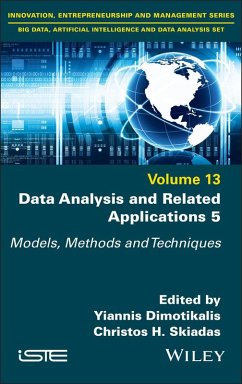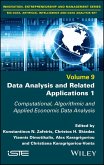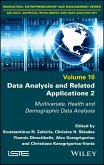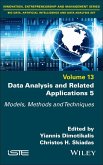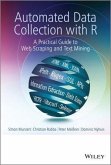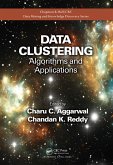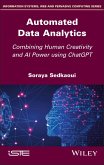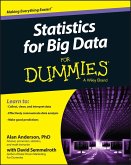Data Analysis and Related Applications, Volume 5 (eBook, ePUB)
Models, Methods and Techniques
Redaktion: Dimotikalis, Yiannis; Skiadas, Christos H.


Alle Infos zum eBook verschenken

Data Analysis and Related Applications, Volume 5 (eBook, ePUB)
Models, Methods and Techniques
Redaktion: Dimotikalis, Yiannis; Skiadas, Christos H.
- Format: ePub
- Merkliste
- Auf die Merkliste
- Bewerten Bewerten
- Teilen
- Produkt teilen
- Produkterinnerung
- Produkterinnerung

Hier können Sie sich einloggen

Bitte loggen Sie sich zunächst in Ihr Kundenkonto ein oder registrieren Sie sich bei bücher.de, um das eBook-Abo tolino select nutzen zu können.
This book is a collective work by several leading scientists, analysts, engineers, mathematicians and statisticians, who have been working at the forefront of data analysis and related applications, arising from data science, operations research, engineering, machine learning or statistics.
Data Analysis and Related Applications 5 represents a cross-section of current concerns and research interests in the above scientific areas. The collected material has been divided into appropriate sections to provide the reader with both theoretical and applied information on data analysis methods, models and techniques, along with appropriate applications.…mehr
- Geräte: eReader
- mit Kopierschutz
- eBook Hilfe
- Größe: 17.58MB
![Data Analysis and Related Applications, Volume 1 (eBook, ePUB) Data Analysis and Related Applications, Volume 1 (eBook, ePUB)]() Data Analysis and Related Applications, Volume 1 (eBook, ePUB)126,99 €
Data Analysis and Related Applications, Volume 1 (eBook, ePUB)126,99 €![Data Analysis and Related Applications, Volume 2 (eBook, ePUB) Data Analysis and Related Applications, Volume 2 (eBook, ePUB)]() Data Analysis and Related Applications, Volume 2 (eBook, ePUB)126,99 €
Data Analysis and Related Applications, Volume 2 (eBook, ePUB)126,99 €![Data Analysis and Related Applications, Volume 5 (eBook, PDF) Data Analysis and Related Applications, Volume 5 (eBook, PDF)]() Data Analysis and Related Applications, Volume 5 (eBook, PDF)126,99 €
Data Analysis and Related Applications, Volume 5 (eBook, PDF)126,99 €![Automated Data Collection with R (eBook, ePUB) Automated Data Collection with R (eBook, ePUB)]() Simon MunzertAutomated Data Collection with R (eBook, ePUB)60,99 €
Simon MunzertAutomated Data Collection with R (eBook, ePUB)60,99 €![Data Clustering (eBook, ePUB) Data Clustering (eBook, ePUB)]() Data Clustering (eBook, ePUB)123,95 €
Data Clustering (eBook, ePUB)123,95 €![Automated Data Analytics (eBook, ePUB) Automated Data Analytics (eBook, ePUB)]() Soraya SedkaouiAutomated Data Analytics (eBook, ePUB)126,99 €
Soraya SedkaouiAutomated Data Analytics (eBook, ePUB)126,99 €![Statistics for Big Data For Dummies (eBook, ePUB) Statistics for Big Data For Dummies (eBook, ePUB)]() Alan AndersonStatistics for Big Data For Dummies (eBook, ePUB)15,99 €
Alan AndersonStatistics for Big Data For Dummies (eBook, ePUB)15,99 €-
-
-
Data Analysis and Related Applications 5 represents a cross-section of current concerns and research interests in the above scientific areas. The collected material has been divided into appropriate sections to provide the reader with both theoretical and applied information on data analysis methods, models and techniques, along with appropriate applications.
Dieser Download kann aus rechtlichen Gründen nur mit Rechnungsadresse in D ausgeliefert werden.
- Produktdetails
- Verlag: Wiley
- Seitenzahl: 614
- Erscheinungstermin: 19. August 2025
- Englisch
- ISBN-13: 9781394401598
- Artikelnr.: 75261462
- Verlag: Wiley
- Seitenzahl: 614
- Erscheinungstermin: 19. August 2025
- Englisch
- ISBN-13: 9781394401598
- Artikelnr.: 75261462
- Herstellerkennzeichnung Die Herstellerinformationen sind derzeit nicht verfügbar.
H p) EVI estimation 81 6.2.2 WTC estimation 83 6.3 Classes of PORT-GMs (PGMs) WTC-estimators 84 6.4 Monte Carlo simulation of the PORT-GPM p (PGPM p) WTC-estimators 85 6.5 Overall comments and open research topics 89 6.6 Acknowledgments 91 6.7 References 91 Chapter 7 What Can we Learn from Malta? An Exploration of Gender Disparities in Education, Work and Money in Europe 95 Erika GRAMMATICA, Francesca GRESELIN and Mariangela ZENGA 7.1 Introduction 95 7.2 Gender gap: education, work and money 96 7.3 Gender Equality Index 98 7.4 Three-way data approach based on principal component analysis 100 7.5 Evidence from principal component analysis 102 7.6 Results of trajectory analysis 103 7.7 Conclusions 106 7.8 Acknowledgments 106 7.9 References 107 Chapter 8 Financial Analysis of a Public Hospital: The Case of the Corfu General Hospital 109 Margarita IOANNIDOU and George MATALLIOTAKIS 8.1 Introduction 109 8.2 Materials and methods 110 8.3 Results 110 8.3.1 Liquidity ratios 110 8.3.2 Financial structure and viability ratios 111 8.3.3 Activity ratios 112 8.3.4 Profitability ratios 113 8.4 Discussion 114 8.5 References 115 Chapter 9 EWMA Control Charts for Skewed Distributions 117 Derya KARAGÖZ and Moustapha Aminou TUKUR 9.1 Introduction 117 9.2 Exponentially weighted moving average control charts 119 9.3 EMMA control charts for the non-normal process 120 9.3.1 The WV EWMA control chart 121 9.3.2 The WSD EWMA control chart 121 9.3.3 Newly proposed SC EWMA control chart 122 9.4 Real data 122 9.5 Simulation study 125 9.6 Simulation algorithm 126 9.7 Results and discussion 127 9.8 Conclusion 131 9.9 References 133 Chapter 10 Assessing the Impact of Renewable Energy Sources on Energy Economics: A Non-Linear Regression Analysis of Hellenic Energy Exchange Market Clearing Prices 135 Emmanuel KARAPIDAKIS, Yiannis KATSIGIANNIS, Konstantinos BLAZAKIS, Marios NIKOLOGIANNIS, George MATALLIOTAKIS, Georgios STAVRAKAKIS, Nikos VENIANAKIS and Paolo BONFINI 10.1 Introduction 135 10.2 Methodology 137 10.2.1 Spearman's rank 137 10.2.2 Sparse autoencoder 139 10.3 Results 140 10.4 Discussion 142 10.5 Conclusions 143 10.6 Acknowledgments 143 10.7 References 144 Chapter 11 Enhancing Energy Market Stability: Comparative Analysis of Forecasting Techniques for Market Clearing Prices in the Day-Ahead Market 147 Emmanuel KARAPIDAKIS, Yiannis KATSIGIANNIS, Konstantinos BLAZAKIS, Marios NIKOLOGIANNIS, George MATALLIOTAKIS, Georgios STAVRAKAKIS, Nikos VENIANAKIS and Nikolaos SCHETAKIS 11.1 Introduction 147 11.2 Methodology 150 11.3 Results 152 11.4 Discussion 155 11.5 Conclusions 155 11.6 Acknowledgments 155 11.7 References 156 Chapter 12 Using the Coxian Continuous-Time Hidden Markov Model to Analyze Lombardy Region Wards for Older Individuals 159 Hannah MITCHELL, Adele H. MARSHALL and Mariangela ZENGA 12.1 Introduction 160 12.2 Methodology 161 12.3 Data and results 165 12.3.1 Data 165 12.3.2 Results 165 12.4 Conclusions 172 12.5 Practice implications 172 12.6 Conflict of interest 173 12.7 References 173 Chapter 13 Estimators for Extreme Value Index: Advancements in Tail Inference 177 Ayana MATEUS and Frederico CAEIRO 13.1 Introduction 177 13.2 Estimators for the tail parameters 179 13.2.1 The new class of estimators for the EVI 179 13.2.2 Asymptotic properties of the GPWM estimators 181 13.2.3 Estimating an extreme quantile 182 13.3 Monte Carlo simulation study of the GPWM estimators 182 13.3.1 Methodology 183 13.3.2 Results 183 13.4 Conclusion 185 13.5 Acknowledgments 185 13.6 References 185 Chapter 14 Determinants of Students' Attitude Toward History: An Empirical Approach 187 Aristea MAVROGIANNI, Eleni VASILAKI and Maria GRYDAKI 14.1 Introduction 188 14.2 Previous research 190 14.2.1 Attitude toward history 190 14.2.2 Educational factors 191 14.2.3 Socioeconomic factors 191 14.3 Data and methods 194 14.3.1 Data 194 14.3.2 Empirical methodology 197 14.4 Results 198 14.5 Summary and conclusions 203 14.6 Appendices 204 14.6.1 Appendix A: the initial full questionnaire for the attitude survey toward history (EDIS) 204 14.6.2 Appendix B: the final questionnaire for the attitude survey toward history (EDIS) 206 14.6.3 Appendix C 207 14.7 References 208 Chapter 15 Methodological Procedures for Assessing the Quality of Death Certificates Due to Unknown Causes 217 Neir Antunes PAES 15.1 Introduction 217 15.2 Methods 219 15.2.1 First step: correction of underregistration of deaths (f) 220 15.2.2 Second step: redistribution of deaths due to ill-defined causes 223 15.2.3 Third step: redistribution of deaths due to non-specific causes (garbage codes) 226 15.3 Illustrative example 227 15.4 Conclusions 230 15.5 References 230 Chapter 16 Health Status, Cancer and Pneumonia Death Rates in Europe: 2019-2022 233 Elena
ÍHOVÁ and Kornélia SVA
INOVÁ 16.1 Introduction 233 16.2 Background 234 16.3 Methods 235 16.4 Results and discussion 237 16.4 Conclusions 244 16.5 References 244 Chapter 17 A Bayesian Asymmetric Approach to Modeling Volatility on Portfolios with Many Assets 247 David SUDA, Monique Borg INGUANEZ and Matthew CAMILLERI 17.1 Introduction 247 17.2 Dynamic principal component analysis 248 17.3 Bayesian Student-t GJR(1,1) model 250 17.4 Asymmetric modeling of a portfolio with many assets 251 17.5 Forecasting, predictive ability and risk estimation 253 17.6 Conclusion 256 17.7 References 256 Chapter 18 Pandemic-Driven Innovations: Utilizing Online Learning and Big Data Analysis for Decision-Making in Educational Environments 259 Leonidas THEODORAKOPOULOS, Ioanna KALLIAMPAKOU, Alexandra THEODOROPOULOU and Gerasimos KALOGERATOS 18.1 Introduction 260 18.2 Literature review 260 18.2.1 Difficulties during the COVID-19 period 260 18.2.2 Effects of COVID-19 on education 261 18.2.3 Big data analysis in educational research 262 18.2.4 Related work 263 18.3 Methodology 264 18.4 Research questions 264 18.4.1 Dataset presentation 265 18.5 Conclusion 273 18.6 Suggestions for further research 274 18.7 References 274 Chapter 19 Credit Card Fraud Detection with Machine Learning and Big Data Analytics: A PySpark Framework Implementation 281 Leonidas THEODORAKOPOULOS, Ioanna KALLIAMPAKOU, Alexandra THEODOROPOULOU and Fotini ZAKKA 19.1 Introduction 281 19.2 Literature review 283 19.2.1 Introduction to credit card fraud detection 283 19.2.2 The importance of detecting credit card fraud 284 19.2.3 Role of machine learning in improving decision-making processes in fraud detection 284 19.2.4 Automated pattern recognition 285 19.2.5 Predictive modeling 285 19.2.6 Dynamic risk scoring 285 19.2.7 Anomaly detection 286 19.2.8 Natural language processing (NLP) 286 19.2.9 Integration with existing systems 286 19.2.10 Credit card fraud detection: machine learning applications 286 19.2.11 Credit card fraud detection using Apache Spark 287 19.2.12 How can machine learning algorithms enhance decision quality in detecting fraud? 288 19.2.13 Improved detection accuracy 288 19.2.14 Real-time processing and analysis 288 19.2.15 Handling big data and complex variables 289 19.2.16 Adaptive learning for evolving threats 289 19.2.17 Cost efficiency through automation 289 19.2.18 Enhanced scalability 289 19.3 Materials and methods 290 19.3.1 Performance evaluation 292 19.4 Results 307 19.4.1 Comparative analysis 314 19.5 Conclusions 315 19.6 Future work 317 19.7 Limitations 317 19.8 References 318 Chapter 20 Quantitative Modeling of the Demographic Aging Process 323 Gräyna TRZPIOT 20.1 Introduction 323 20.2 Literature review 324 20.3 Methodology 325 20.3.1 Dependency ratios - double aging index 327 20.3.2 Multivariate regression model for the double aging index 330 20.4 Research results and discussion 330 20.5 Conclusions 331 20.6 References 332 Chapter 21 Hotel Sales During COVID-19: Evidence from the United States 333 Dimitrios VORTELINOS, Christos FLOROS, Alexandros APOSTOLAKIS and Ioannis PASSAS 21.1 Introduction 333 21.2 Literature review 334 21.3 Travel and tourism economic impact in 2022 335 21.3.1 Travel and tourism GDP 335 21.3.2 Travel and tourism employment 335 21.3.3 Travel and tourism forecasts 336 21.4 Key developments in the hospitality sector in 2022 336 21.4.1 Overall highlights 336 21.4.2 Hotel room demand 337 21.4.3 Occupancy 337 21.4.4 Room revenue 338 21.4.5 Workforce 338 21.4.6 State and local tax revenue 338 21.4.7 US hotel markets 339 21.5 Data and methodology 340 21.5.1 Data description 340 21.5.2 Methodology 340 21.5.3 LARC score 340 21.5.4 Graphical analysis of variables 341 21.6 Results 343 21.7 Concluding remarks and future research 346 21.8 Acknowledgments 346 21.9 References 346 Chapter 22 Investigating the Mediating Role of Religious Services Attendance in the Relationship Between Religion Variables and Social Class Perceptions 349 Aggeliki YFANTI and Catherine MICHALOPOULOU 22.1 Introduction 349 22.2 Method 351 22.2.1 Procedure and participants 351 22.2.2 Measures 352 22.2.3 Statistical analyses 353 22.3 Results 355 22.3.1 Univariate analyses 355 22.3.2 Bivariate analyses: correlation analyses 359 22.3.3 Multivariate analyses: mediation analyses 360 22.4 Conclusions 362 22.5 References 363 Chapter 23 New Methods of Constructing Confidence Intervals of a Sensitive Proportion in Survey Statistics 365 Marta ZALEWSKA and Wojciech NIEMIRO 23.1 Introduction 365 23.2 Method of moments (MM) for ICT data 367 23.3 EM estimation for ICT data and parametric bootstrap 367 23.3.1 Maximum likelihood via the EM algorithm 368 23.3.2 Percentile parametric bootstrap confidence intervals 369 23.4 "Almost exact" confidence intervals for ICT data 369 23.5 Simulation results 371 23.6 Conclusions 375 23.7 References 375 Chapter 24 Spreading Diseases Models Under Vaccination 377 S. ZIMERAS and D. VASILEIOU 24.1 Introduction 377 24.2 Modeling epidemic disease 378 24.3 Vaccination models analysis 380 24.4 SEIVR model 380 24.5 SIRV model 382 24.6 Conclusions 384 24.7 References 385 List of Authors 387 Index 393
H p) EVI estimation 81 6.2.2 WTC estimation 83 6.3 Classes of PORT-GMs (PGMs) WTC-estimators 84 6.4 Monte Carlo simulation of the PORT-GPM p (PGPM p) WTC-estimators 85 6.5 Overall comments and open research topics 89 6.6 Acknowledgments 91 6.7 References 91 Chapter 7 What Can we Learn from Malta? An Exploration of Gender Disparities in Education, Work and Money in Europe 95 Erika GRAMMATICA, Francesca GRESELIN and Mariangela ZENGA 7.1 Introduction 95 7.2 Gender gap: education, work and money 96 7.3 Gender Equality Index 98 7.4 Three-way data approach based on principal component analysis 100 7.5 Evidence from principal component analysis 102 7.6 Results of trajectory analysis 103 7.7 Conclusions 106 7.8 Acknowledgments 106 7.9 References 107 Chapter 8 Financial Analysis of a Public Hospital: The Case of the Corfu General Hospital 109 Margarita IOANNIDOU and George MATALLIOTAKIS 8.1 Introduction 109 8.2 Materials and methods 110 8.3 Results 110 8.3.1 Liquidity ratios 110 8.3.2 Financial structure and viability ratios 111 8.3.3 Activity ratios 112 8.3.4 Profitability ratios 113 8.4 Discussion 114 8.5 References 115 Chapter 9 EWMA Control Charts for Skewed Distributions 117 Derya KARAGÖZ and Moustapha Aminou TUKUR 9.1 Introduction 117 9.2 Exponentially weighted moving average control charts 119 9.3 EMMA control charts for the non-normal process 120 9.3.1 The WV EWMA control chart 121 9.3.2 The WSD EWMA control chart 121 9.3.3 Newly proposed SC EWMA control chart 122 9.4 Real data 122 9.5 Simulation study 125 9.6 Simulation algorithm 126 9.7 Results and discussion 127 9.8 Conclusion 131 9.9 References 133 Chapter 10 Assessing the Impact of Renewable Energy Sources on Energy Economics: A Non-Linear Regression Analysis of Hellenic Energy Exchange Market Clearing Prices 135 Emmanuel KARAPIDAKIS, Yiannis KATSIGIANNIS, Konstantinos BLAZAKIS, Marios NIKOLOGIANNIS, George MATALLIOTAKIS, Georgios STAVRAKAKIS, Nikos VENIANAKIS and Paolo BONFINI 10.1 Introduction 135 10.2 Methodology 137 10.2.1 Spearman's rank 137 10.2.2 Sparse autoencoder 139 10.3 Results 140 10.4 Discussion 142 10.5 Conclusions 143 10.6 Acknowledgments 143 10.7 References 144 Chapter 11 Enhancing Energy Market Stability: Comparative Analysis of Forecasting Techniques for Market Clearing Prices in the Day-Ahead Market 147 Emmanuel KARAPIDAKIS, Yiannis KATSIGIANNIS, Konstantinos BLAZAKIS, Marios NIKOLOGIANNIS, George MATALLIOTAKIS, Georgios STAVRAKAKIS, Nikos VENIANAKIS and Nikolaos SCHETAKIS 11.1 Introduction 147 11.2 Methodology 150 11.3 Results 152 11.4 Discussion 155 11.5 Conclusions 155 11.6 Acknowledgments 155 11.7 References 156 Chapter 12 Using the Coxian Continuous-Time Hidden Markov Model to Analyze Lombardy Region Wards for Older Individuals 159 Hannah MITCHELL, Adele H. MARSHALL and Mariangela ZENGA 12.1 Introduction 160 12.2 Methodology 161 12.3 Data and results 165 12.3.1 Data 165 12.3.2 Results 165 12.4 Conclusions 172 12.5 Practice implications 172 12.6 Conflict of interest 173 12.7 References 173 Chapter 13 Estimators for Extreme Value Index: Advancements in Tail Inference 177 Ayana MATEUS and Frederico CAEIRO 13.1 Introduction 177 13.2 Estimators for the tail parameters 179 13.2.1 The new class of estimators for the EVI 179 13.2.2 Asymptotic properties of the GPWM estimators 181 13.2.3 Estimating an extreme quantile 182 13.3 Monte Carlo simulation study of the GPWM estimators 182 13.3.1 Methodology 183 13.3.2 Results 183 13.4 Conclusion 185 13.5 Acknowledgments 185 13.6 References 185 Chapter 14 Determinants of Students' Attitude Toward History: An Empirical Approach 187 Aristea MAVROGIANNI, Eleni VASILAKI and Maria GRYDAKI 14.1 Introduction 188 14.2 Previous research 190 14.2.1 Attitude toward history 190 14.2.2 Educational factors 191 14.2.3 Socioeconomic factors 191 14.3 Data and methods 194 14.3.1 Data 194 14.3.2 Empirical methodology 197 14.4 Results 198 14.5 Summary and conclusions 203 14.6 Appendices 204 14.6.1 Appendix A: the initial full questionnaire for the attitude survey toward history (EDIS) 204 14.6.2 Appendix B: the final questionnaire for the attitude survey toward history (EDIS) 206 14.6.3 Appendix C 207 14.7 References 208 Chapter 15 Methodological Procedures for Assessing the Quality of Death Certificates Due to Unknown Causes 217 Neir Antunes PAES 15.1 Introduction 217 15.2 Methods 219 15.2.1 First step: correction of underregistration of deaths (f) 220 15.2.2 Second step: redistribution of deaths due to ill-defined causes 223 15.2.3 Third step: redistribution of deaths due to non-specific causes (garbage codes) 226 15.3 Illustrative example 227 15.4 Conclusions 230 15.5 References 230 Chapter 16 Health Status, Cancer and Pneumonia Death Rates in Europe: 2019-2022 233 Elena
ÍHOVÁ and Kornélia SVA
INOVÁ 16.1 Introduction 233 16.2 Background 234 16.3 Methods 235 16.4 Results and discussion 237 16.4 Conclusions 244 16.5 References 244 Chapter 17 A Bayesian Asymmetric Approach to Modeling Volatility on Portfolios with Many Assets 247 David SUDA, Monique Borg INGUANEZ and Matthew CAMILLERI 17.1 Introduction 247 17.2 Dynamic principal component analysis 248 17.3 Bayesian Student-t GJR(1,1) model 250 17.4 Asymmetric modeling of a portfolio with many assets 251 17.5 Forecasting, predictive ability and risk estimation 253 17.6 Conclusion 256 17.7 References 256 Chapter 18 Pandemic-Driven Innovations: Utilizing Online Learning and Big Data Analysis for Decision-Making in Educational Environments 259 Leonidas THEODORAKOPOULOS, Ioanna KALLIAMPAKOU, Alexandra THEODOROPOULOU and Gerasimos KALOGERATOS 18.1 Introduction 260 18.2 Literature review 260 18.2.1 Difficulties during the COVID-19 period 260 18.2.2 Effects of COVID-19 on education 261 18.2.3 Big data analysis in educational research 262 18.2.4 Related work 263 18.3 Methodology 264 18.4 Research questions 264 18.4.1 Dataset presentation 265 18.5 Conclusion 273 18.6 Suggestions for further research 274 18.7 References 274 Chapter 19 Credit Card Fraud Detection with Machine Learning and Big Data Analytics: A PySpark Framework Implementation 281 Leonidas THEODORAKOPOULOS, Ioanna KALLIAMPAKOU, Alexandra THEODOROPOULOU and Fotini ZAKKA 19.1 Introduction 281 19.2 Literature review 283 19.2.1 Introduction to credit card fraud detection 283 19.2.2 The importance of detecting credit card fraud 284 19.2.3 Role of machine learning in improving decision-making processes in fraud detection 284 19.2.4 Automated pattern recognition 285 19.2.5 Predictive modeling 285 19.2.6 Dynamic risk scoring 285 19.2.7 Anomaly detection 286 19.2.8 Natural language processing (NLP) 286 19.2.9 Integration with existing systems 286 19.2.10 Credit card fraud detection: machine learning applications 286 19.2.11 Credit card fraud detection using Apache Spark 287 19.2.12 How can machine learning algorithms enhance decision quality in detecting fraud? 288 19.2.13 Improved detection accuracy 288 19.2.14 Real-time processing and analysis 288 19.2.15 Handling big data and complex variables 289 19.2.16 Adaptive learning for evolving threats 289 19.2.17 Cost efficiency through automation 289 19.2.18 Enhanced scalability 289 19.3 Materials and methods 290 19.3.1 Performance evaluation 292 19.4 Results 307 19.4.1 Comparative analysis 314 19.5 Conclusions 315 19.6 Future work 317 19.7 Limitations 317 19.8 References 318 Chapter 20 Quantitative Modeling of the Demographic Aging Process 323 Gräyna TRZPIOT 20.1 Introduction 323 20.2 Literature review 324 20.3 Methodology 325 20.3.1 Dependency ratios - double aging index 327 20.3.2 Multivariate regression model for the double aging index 330 20.4 Research results and discussion 330 20.5 Conclusions 331 20.6 References 332 Chapter 21 Hotel Sales During COVID-19: Evidence from the United States 333 Dimitrios VORTELINOS, Christos FLOROS, Alexandros APOSTOLAKIS and Ioannis PASSAS 21.1 Introduction 333 21.2 Literature review 334 21.3 Travel and tourism economic impact in 2022 335 21.3.1 Travel and tourism GDP 335 21.3.2 Travel and tourism employment 335 21.3.3 Travel and tourism forecasts 336 21.4 Key developments in the hospitality sector in 2022 336 21.4.1 Overall highlights 336 21.4.2 Hotel room demand 337 21.4.3 Occupancy 337 21.4.4 Room revenue 338 21.4.5 Workforce 338 21.4.6 State and local tax revenue 338 21.4.7 US hotel markets 339 21.5 Data and methodology 340 21.5.1 Data description 340 21.5.2 Methodology 340 21.5.3 LARC score 340 21.5.4 Graphical analysis of variables 341 21.6 Results 343 21.7 Concluding remarks and future research 346 21.8 Acknowledgments 346 21.9 References 346 Chapter 22 Investigating the Mediating Role of Religious Services Attendance in the Relationship Between Religion Variables and Social Class Perceptions 349 Aggeliki YFANTI and Catherine MICHALOPOULOU 22.1 Introduction 349 22.2 Method 351 22.2.1 Procedure and participants 351 22.2.2 Measures 352 22.2.3 Statistical analyses 353 22.3 Results 355 22.3.1 Univariate analyses 355 22.3.2 Bivariate analyses: correlation analyses 359 22.3.3 Multivariate analyses: mediation analyses 360 22.4 Conclusions 362 22.5 References 363 Chapter 23 New Methods of Constructing Confidence Intervals of a Sensitive Proportion in Survey Statistics 365 Marta ZALEWSKA and Wojciech NIEMIRO 23.1 Introduction 365 23.2 Method of moments (MM) for ICT data 367 23.3 EM estimation for ICT data and parametric bootstrap 367 23.3.1 Maximum likelihood via the EM algorithm 368 23.3.2 Percentile parametric bootstrap confidence intervals 369 23.4 "Almost exact" confidence intervals for ICT data 369 23.5 Simulation results 371 23.6 Conclusions 375 23.7 References 375 Chapter 24 Spreading Diseases Models Under Vaccination 377 S. ZIMERAS and D. VASILEIOU 24.1 Introduction 377 24.2 Modeling epidemic disease 378 24.3 Vaccination models analysis 380 24.4 SEIVR model 380 24.5 SIRV model 382 24.6 Conclusions 384 24.7 References 385 List of Authors 387 Index 393
